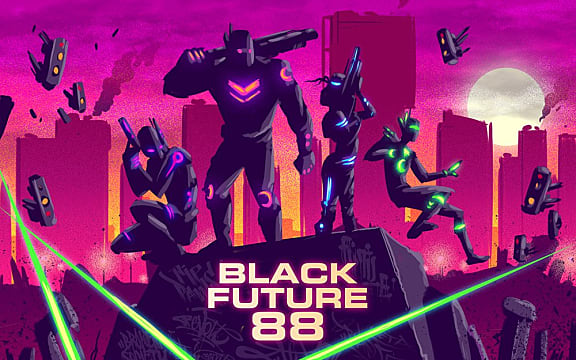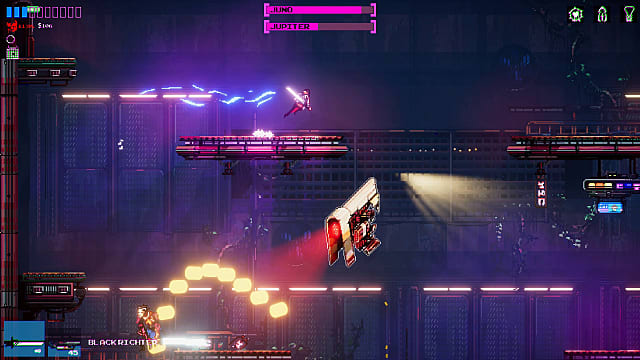

Let's get the obvious out of the way immediately: Yes, Black Future '88 has a lot in common with Dead Cells. Both games are stylish, neon-soaked indie roguelikes with fast-paced sidescrolling combat and procedural levels.
However, they actually differ in just about as many ways as they are similar if you dig beneath the surface.
Black Future '88 is a game I ended up spending a lot more time with than I initially expected. A big part of that was due to playing it on the Nintendo Switch. Quick, pointed, and well-designed games like this on a portable console such as the Switch feel like a perfect content meets hardware pairing.
Black Future '88 Review: Retrofuturism
Perhaps my favorite subgenre of sci-fi is retrofuturism, or rather the idealized version of the future that inhabited fictional worlds created decades earlier. Stuff like Back to the Future 2, Blade Runner, and many of the synth-wave neon-colored visuals you see in a lot of classic works of art fall into this category. They are versions of the future that we have surpassed on the calendar but never realized in reality. That's precisely where Black Future '88 falls.
In the world of Black Future '88, a nuclear bomb falls in the summer of the titular year and completely blacks out the sun with endless amounts of rainfall. As a result, with no concept of day or night, the world decides to stop keeping track of time. It's been 1988 ever since and now everything is measured in minutes left to live.
That's a pretty stellar concept for a setting, right? It's rare to hear something original these days so kudos in that regard. In a way, it's a bit of a shame the lore isn't explored much more than that, leaving you with little direction or narrative significance other than just trying to stay alive.
You'll unlock a few options for characters as you go, each with different pros and cons, but they don't actually control that differently so it hardly changes the way you play the game. Co-op works well and adds even more ingredients to the chaos, so it's certainly worth a go if you've got someone to light things up with.
The repeatable gimmick underlying Black Future '88 and what makes it a roguelike is that you've only got 16 minutes left to live before your heart explodes. So in order to make the most of the time you've got left as one of the last remaining survivors, you must climb to the top of the tower as quickly as possible and take out all of the "warden" bosses along the way.
It's a simple concept that's made interesting by the procedural layout and bevy of weapons at your disposal.
But the main issue I had with Black Future '88 is that it's overall a bit shallow. Without a strong story pushing you through, a lack of hand-crafted high-quality bespoke content, and generally repetitive layouts (even for a roguelike), it wore out its novelty more quickly than other games in the genre.
You'll still likely get a solid 10+ hours out of it depending on how invested you get or how difficult you find it, but it doesn't have as much meat on its bones as some of its contemporaries.
Live To Die
Death in Black Future '88 comes swiftly, especially during your first few hours with the game. Enemies tend to do loads of damage quickly, and it's not uncommon for the screen to imitate a bullet-hell shooter during a tense battle. Luckily, you can dash through projectiles and enemies to dodge and start every run with two weapons from the get-go.
Despite the selection being plentiful, though, I did find myself wishing for a bit more variety in weapon types. Generally, weapons devolve into powerful single shot or spray and pray globs of projectiles. There are melee weapons too, but Black Future '88 felt best played as a mostly ranged-based shooter than a mixture of melee and guns.
As you defeat enemies you can pick up new weapons that they drop. Every few rooms, you'll find portals to instances that let you equip upgrades and/or curses that both aid and hinder you. It's a bit of a balancing act.
Some of the best upgrades will cost you minutes from your remaining pool of time, offering a clever gamble of how confident you feel in your ability to dispense enemies quickly.
Visually it's a blast with bright, neon colors peppering the screen, bursting with effects and illuminating the environment. The lighting alone is remarkable and it's aided by an excellent synth-wave soundtrack that is worth listening to even outside of playing the game.
Black Future Review — The Bottom Line
Pros:
- Snappy and satisfying gameplay
- Beautiful neon-themed color palette
- Amazing synthwave soundtrack
- Clever premise that explains the roguelike structure
Cons:
- Gets pretty repetitive, even for a roguelike
- Creative lore is underutilized
- Relatively shallow in terms of content and variety
Black Future '88 isn't going to redefine what it means to be a roguelike, but it does a great job at selling itself with bold colors, pumping music, and frantic gameplay.
It's the type of game that gives you exactly what you expect based on trailers and screenshots, even if that might mean a really well-made roguelike that's a bit shallow but packs plenty of replayability and fun.
[Note: Good Shepherd Entertainment provided a copy of Black Future '88 for the purpose of this review.]



0 comments:
Post a Comment